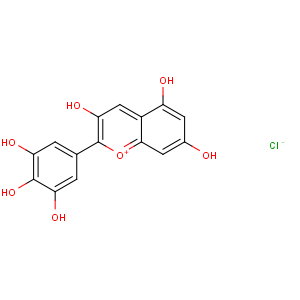Title: Delphinidin
CAS Registry Number: 528-53-0
CAS Name: 3,5,7-Trihydroxy-2-(3,4,5-trihydroxyphenyl)-1-benzopyrylium chloride
Synonyms: 3,3¢,4¢,5,5¢,7-hexahydroxyflavylium chloride; 3,3¢,4¢,5,5¢,7-hexahydroxy-2-phenylbenzopyrylium chloride; delphinidol
Molecular Formula: C15H11ClO7
Molecular Weight: 338.70
Percent Composition: C 53.19%, H 3.27%, Cl 10.47%, O 33.07%
Literature References: The aglucone of delphinin: Willst?tter, Mieg,
Ann. 408, 61 (1915); the aglucone of violanin: Willst?tter, Weil,
ibid. 412, 178 (1917). Occurrence in plants: Acheson,
Can. J. Biochem. Physiol. 37, 1 (1959). Synthesis: Pratt, Robinson,
J. Chem. Soc. 127, 166 (1925); Bradley
et al., ibid. 1930, 793.
Properties: Chocolate-brown prisms or needles with metallic luster from 5% HCl. Crystallizes from water with 1, 2 or 4 mols H2O. When anhydr does not melt below 350°. Absorption max (methanolic HCl): 544 nm. Sol in methanol, ethanol, ethyl acetate.
Absorption maximum: Absorption max (methanolic HCl): 544 nm
Derivative Type: 3-Glucoside
Synonyms: Myrtillin-a
Molecular Formula: C21H21ClO12
Molecular Weight: 500.84
Percent Composition: C 50.36%, H 4.23%, Cl 7.08%, O 38.33%
Literature References: From the whortleberry
(Vaccinium myrtillus L.,
Ericaceae): Willst?tter, Zollinger,
Ann. 408, 83 (1915);
412, 195 (1916); from the pansy
(Viola tricolor L.,
Violaceae): Karrer, de Meuron,
Helv. Chim. Acta 16, 292 (1933). Structure and synthesis: Reynolds, Robinson,
J. Chem. Soc. 1934, 1039.
Properties: Deep purple crystals from dil HCl. Absorption max (methanolic HCl): 535 nm.
Absorption maximum: Absorption max (methanolic HCl): 535 nm
Derivative Type: 3,5-Diglucoside
Synonyms: 3,5-Bis(glucosyloxy)-3¢,4¢,5¢,7-tetrahydroxyflavylium chloride; delphin; delphoside; hyacin
Molecular Formula: C27H31ClO17
Molecular Weight: 662.98
Percent Composition: C 48.91%, H 4.71%, Cl 5.35%, O 41.03%
Literature References: From flowers of
Salvia patens Cav.,
Labiatae, structure and synthesis: Reynolds
et al., J. Chem. Soc. 1934, 1235; from flowers of
Verbena hybrida Hart.,
Verbenaceae: Scott-Moncrieff, Sturgess,
Biochem. J. 34, 268 (1940); from grape skins: Bockian
et al., J. Agric. Food Chem. 3, 695 (1955). Identity with hyacin: Saito
et al., Proc. Jpn. Acad. 36, 340 (1960).
Properties: Leaflets with bronze luster from dil HCl. Absorption max (methanolic HCl): 534 nm. Practically insol in cold water, alcohol, dil acids; sol in hot dil HCl.
Absorption maximum: Absorption max (methanolic HCl): 534 nm
Derivative Type: Compound with glucose + hydroxybenzoic acid
Synonyms: Delphinin
Molecular Formula: C41H39ClO21
Molecular Weight: 903.19
Percent Composition: C 54.52%, H 4.35%, Cl 3.93%, O 37.20%
Literature References: From
Delphinium consolida L.,
Ranunculaceae: Willst?tter, Mieg,
loc. cit.
Properties: Dark red-brown plates or prisms from 3% HCl. dec 200-203°. Sol in water with decompn, dil alcohol, acetone, boiling alcohol.
Derivative Type: Compound with glucose + rhamnose +
p-hydroxycinnamic acid
Synonyms: Violanin
Molecular Formula: C36H37ClO18
Molecular Weight: 793.12
Percent Composition: C 54.52%, H 4.70%, Cl 4.47%, O 36.31%
Literature References: From flowers of
Viola tricolor L.,
Violaceae: Willst?tter, Weil,
loc. cit. Structure: Karrer, de Meuron,
loc. cit.
Properties: Bluish-violet plates with green metallic luster from methanolic HCl + ether. Sol in amyl alcohol, in 0.15-0.5% HCl; less sol in 1% HCl; slightly sol in water; practically insol in 5-12% HCl.

